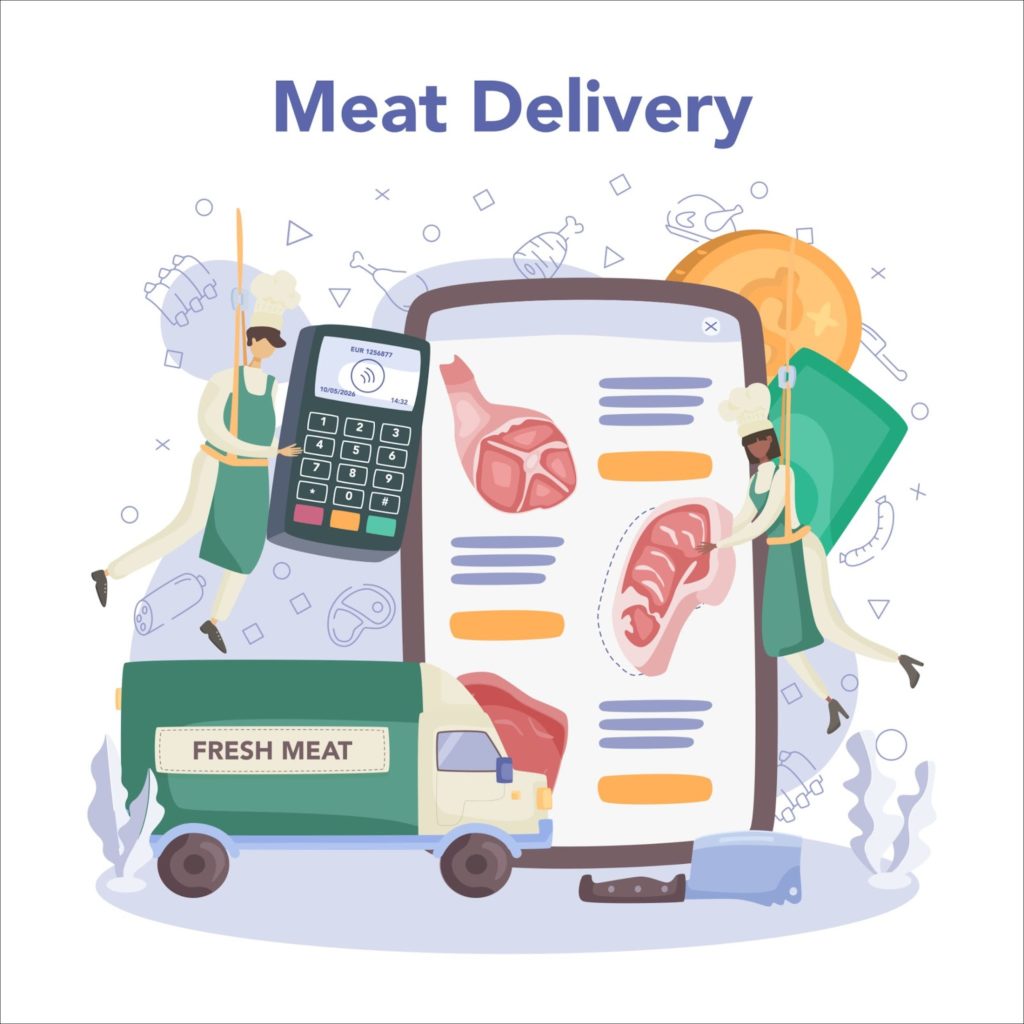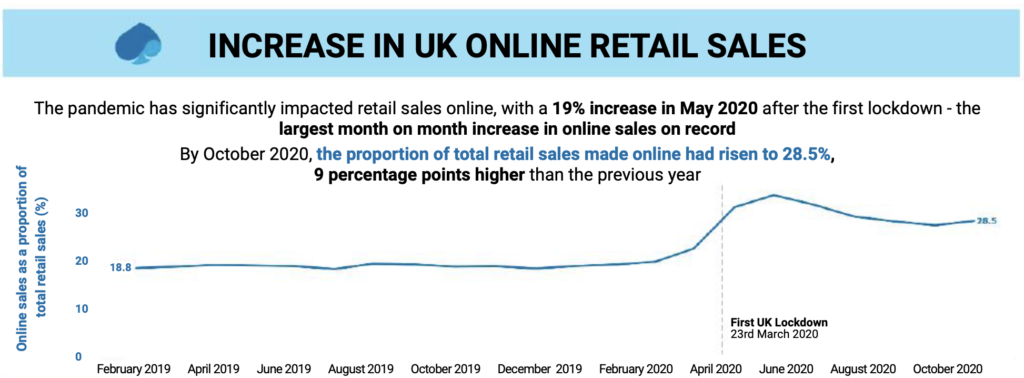
- Products
- Solutions
- Learn
- Partner
- Try Now
An introduction to the food delivery industry
Meat delivery right to the doorstep is not a new swing but has gained in popularity in recent times. Of course, the pandemic deserves some credit, which necessitated online ordering for almost everything under the sky.
There is a shift in consumer behavior and how we shop around for the products we need. As a result, almost every online service vendor had to increase their working capacity. The on-demand delivery industry is not isolated from the pandemic, which includes food delivery services.
The consumers have shifted to online channels, which in turn impacted the online food delivery services and facilitated a system that ensures safe and secure food delivery from the restaurant to the customer.

To build a successful online meat delivery service, one needs to think outside the box. As the existing providers have spoiled the customers with faster services.
To sustain within this space and to build a greater impression on the users, one must have a solution that improves user experience and offers better solutions than the existing ones.
This article aims to help build a meat delivery service. We bring an incredible solution to the table which offers a range of custom on-demand solutions with a direct-to-consumer approach.
What follows is a detailed explanation of how to build a meat delivery service. Let’s get cracking!
How’s the Meat Delivery Market Shaping Up?
The global fresh meat packaging market is expected to grow at a rate of 2.7% between 2019 to 2025, but we can expect a further increase due to the accelerated demand.
Among the comprehensive meat delivery services, the frozen meat market stood at $73.3 billion in 2018, with an expected growth rate of 4.4% until 2025. On the other hand, the processed meat market stood at $519.41 billion as of 2019, with an expected growth rate of 6.24%.
Starting a meat delivery service requires in-depth market research. However, the issue is there is no standalone report to provide credible insights into the market. That is why we have brought together different reports related to the meat market for a better understanding.
So, given above is the potential increase in demand for meat in the global market. Below we will try to find some actionable information by accounting for different studies.
Uber saw an increase of 30% in independent drivers signing up for delivery in the US amid the pandemic. Two detailed reports helped us build an understanding of the food delivery demand.
1. According to the findings of a study by Professors at Portland State University titled “Impact of COVID-19 on Home Delivery Purchases and Expenditures,” Canada’s online food delivery demand surged during the lockdown, and the trend continues.


2. Another report from the UK compares the increase in online and offline sales to find a 2x increase in online sales channels. To satisfy rising demand and ensure faster last-mile delivery of meat in the United States, UberEats and Deliveroo teamed with established meat processing companies such as Waitrose, Sainsbury, Aldi, Co-Op, and Morrisons.
So, in every respect, the market of online meat delivery is growing, setting new boundaries, and building the momentum for something bigger. However, to create such a platform, you must follow the right development process.
Things to consider while building a meat delivery service?
The first thing you should do before starting any business is competitor analysis and market research. We have taken care of the market research for you and as for the competitor research, it is an ongoing process, and we shall explore its components in the article.
- Market and Customer Research
- Partner Up with Meat Vendors
- Designing the Interface
- Team Composition and Development
Competitor Research
Unfortunately, you are not the only one looking to build a meat delivery service. There are existing players in the market like Deliveroo, UberEats, Postmates, etc.
So, this research aims to understand how your competitors are operating and delivering the goods from the vendors to the customers. More importantly, you need to look at their mistakes, things the customers would want them to improve, and ensure that you fill the gap by embedding those services/features in your platform.
Before beginning the building process, ensure that you answer these questions.
• Who is my ideal customer?
• What are my customer’s preferences?
• What is the unique proposition that will bring value to the customers?
• Is there a befitting time to launch the business?
• What business model to follow?
The purpose is to validate the idea and to identify the scope of development plus improvement.
The reason why we can hear only a few names in the market like Deliveroo, UberEats, Postmates, or a few others is because of their swelled war chests.
In 2018, $9.6 billion was injected into all sorts of food delivery businesses across the globe. Out of this, the Asian players received 60% of the funding.
All this money is used to run highly targeted customer attraction, retention, and marketing campaigns. Plus, the big players also absorb the smaller ones and broaden their local outreach.
Yes, several big houses are fighting to get the largest market share running cash-burning tactics. But you will still find investors appropriating capital towards building food delivery businesses.
Build Partnerships with Vendors and Suppliers
Launching a meat delivery service means you need to onboard existing meat stores and vendors on the platform for the customers to see and select.
Hence, your first step, even before launching the platform, must be to create partnerships. Reach out to the meat suppliers, pitch the idea and highlight the key benefits for them like better targeting and an extended outreach.
While building connections, make sure to get started on a good footing. The reason being Zomato and GrubHub took the initiative to include several restaurant’s menus on their platform without first taking permission. Some business owners hit GrubHub with a lawsuit for putting the restaurants in a bad light.
These restaurants complained that the staff was unaware of the orders, and the delivery agents came to the restaurant for pick up. Even though the customer will get a refund, it puts a bad light on the restaurant. Thus, you need to take approval to ensure a hassle-free delivery process completion.
More importantly, since the vendors have to give a commission for every order coming from your platform, they need to agree on that. Ergo, reach out to the vendors, get their permission and show them the benefits plus their duties and contribution.
Intuitive, Friendly, and Attractive User Interface and Design
As a delivery service provider, create three different interfaces for the platform.
• For the customers
• For the vendors
• For the drivers
To provide an intuitive user experience, including all of the features that are unique to each of the participants. The drivers, for example, should be able to obtain the vendor and customer addresses with a single click.
The vendors must get complete order information on a single screen along with the request button to call for the delivery guy and inform them when the order is ready.
On the other hand, the customers should be able to access an easy navigation interface with listings divided as per popularity, favorites, and price.
Before actually moving to the development phase, it is better to create design drafts that work like an actual application, a prototype. This will allow you to make the changes saving the development time and cost.
Team Composition for Building a Meat-Delivery Platform
Apart from the team, you also need to choose the ideal tech stack for your platform. This, in turn, is further dependent on the operating systems or devices you want the platform to work on. Consequently, the tech stack to build a platform for the web will be different than building one for an iOS or Android device.
This was a lengthy process to build a meat delivery platform. Remember that we mentioned that there’s another way of building the same platform.
Three team configurations can be applied to build a meat-delivery platform.
- Hire an in-house team
- Hire Freelancers
- Outsource the work to an agency
There are some pros and cons of choosing each prospect. For instance, the in-house team will provide the highest quality product but at a high cost. Although freelancing is cost-effective, controlling them and ensuring timely delivery is a difficult challenge.
Outsourcing the coding work is relatively affordable, and you can also get assured deliverables but communication issues may arise.
Well, this is where Yelo comes in.
What is Yelo, and Why Should You Use It?
Yelo is an online marketplace builder solution that enables users to create and manage their own virtual market. It is built to support all types of marketplaces, such as rentals, professional services, and hyperlocal among others.
Why Yelo?
- Build Without Coding
- Proficient management abilities
- Single-day launch
- Extensive features and functions
- Integrations
- Design your marketplace
- Multiple payment gateways
- Marketing and SEO
- Help and Support
Reasons to use Yelo –
Build Without Coding
One of the best things about Yelo is that you don’t have to hire developers or learn to code to use it. You won’t need to use a drag-and-drop builder. Building with Yelo is as simple as filling out a Form.
Proficient Management Abilities
Marketplace management is one of the areas that Yelo excels at. Building a customized platform from the ground up tends to provide the business with entire control. It allows you to create and manage all of the hyperlocal marketplace’s components, including the admin panel, customer panel, vendor panel, and delivery panel.
Single-day Launch
According to what we’ve seen and heard in the industry, bringing a new product to market takes about six months.
Consider how much work you’ll be able to get done in these six months while your competitors are still developing and revising their products. Yelo allows launching in a single day.
Features and Functions
Yelo has it all, from ordering features to browsing, listings, store management, delivery, payment, checkout, push notifications, tracking, and route optimization. Another benefit is that the advanced features do not require the development of backend infrastructure. Everything will be taken care of by Yelo.
Integrations
It also provides for integration with many other platforms needed to support marketplace operations, such as Kato for analytics, BulBul for CRM, Hippo for customer service, and Tookan for delivery management.
Design Your Marketplace
Yet another reason to use Yelo is that it has inbuilt UI/UX designing and customization features delivered via the themes engine.
Multiple Payment Gateways
Yelo was created to help marketplace owners and operators all around the world. Yelo can be integrated with more than 100 payment gateways to ensure that business owners do not run out of options.
Marketing Offers and SEO
Yelo offers built-in features to assist you with SEO requirements such as meta tags, sitemaps, and instant access to robot.txt files.
For marketing purposes, discounts, gift cards, and loyalty point programs can be used to enhance the marketing results.
Help & Support
Instant and proficient support from the team will help you set up your business hassle-free.
To Sum It Up
Building a meat delivery service platform is a multi-step process that necessitates thorough market research and skilled development techniques.
Yelo is an end-to-end management solution that can be easily used to build a meat delivery platform. Setup a complete meat delivery business with Yelo’s headless commerce, go direct-to-consumer neglecting the middlemen, and having a more transparent connection with the consumers.

Subscribe to stay ahead with the latest updates and entrepreneurial insights!

Subscribe to our newsletter
Get access to the latest industry & product insights.




















